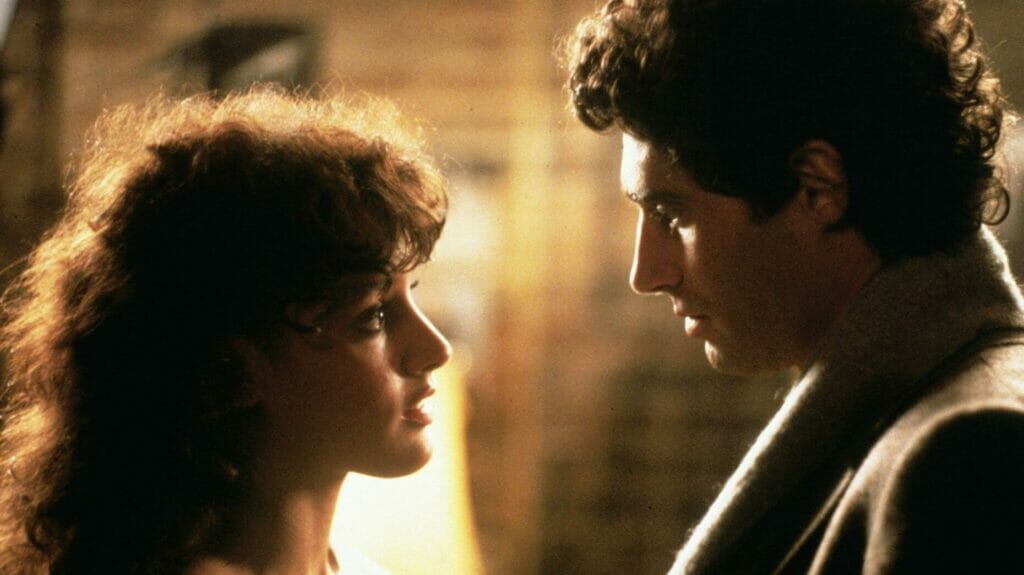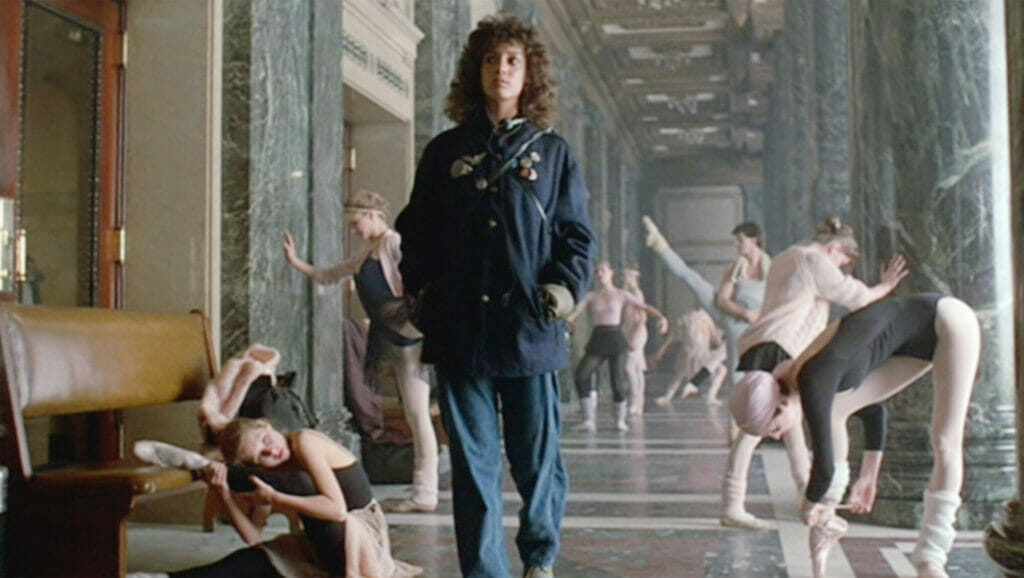Read also:
How to Watch FX Live Without CableHow To Watch AMC Without CableHow to Watch ABC Without CableHow to Watch Paramount Network Without CableForty years on, Adrian Lyne’s tale of welding, dancing, dreaming, and cold-shoulder sweaters still leaves us all feeling like maniacs.
Personally, the notion of referring to films as “guilty pleasures” has always struck me as slightly absurd—if a movie can touch, thrill, amuse, arouse or otherwise entertain you in some way, don’t feel guilty about it.
So when I say that I’ve been a huge fan of Flashdance since its original release in 1983 (and can confirm, via the new 40th anniversary 4K UHD release from Paramount Home Video, that I still adore it), I feel absolutely no guilt or shame. Sure, the film is as preposterous a concoction as has ever been placed before a camera, assembled in such a calculating manner that you practically hear the gears grinding away in the background. But every time I’ve watched it over the years—and that’s a lot—I find myself falling under its goofy spell once more.
For those who have somehow not yet experienced the majesty of Flashdance for themselves, the film concerns Alex Owens (newcomer Jennifer Beals), an eighteen-year-old living with her beloved pet dog Grunt in a giant converted warehouse. She pays for said warehouse by spending her days working as a welder in a steel mill (where she appears to be the only woman on the premises) and her nights dancing at Mawby’s, to be an ordinary neighborhood bar but is somehow able to stage elaborate dance numbers for its patrons, who respond in kind by politely never yelling for the dancers to take anything off.
Of course, the gang at Mawby’s all have dreams to pursue—waitress Jeanie (Sunny Johnson) is training to be a figure skater, and shoe-order cook Richie (Kyle T. Heffner) wants to be a stand-up comic. Alex’s dream? Joining the Pittsburgh Conservatory of Dance to study ballet.

But what good is pursuing a dream if you don’t have a fella by your side? One night, Alex’s dancing catches the attention of customer Nick (Michael Nouri), who actually owns the steel mill where she works. After realizing that she is his employee, he attempts to pursue her romantically, eventually wearing her down to the point where a relationship does develop between them, much to the presumed consternation of the mill’s HR department.
Things are swell for a while, but towards the end of the second act, things begin to go sour for everyone—Alex is too intimidated by the application process for the school to go with it, Jeanie craps out on the ice and starts working as a stripper for the evil rival club and Alex’s dancing mentor (Lilia Skala) dies—and it seems that all is lost. However, with Nick’s support, Alex pulls herself together and goes through with the audition. I suspect you can predict how that turns out.
Put politely, the screenplay by Tom Hedley and Joe Eszterhaus (who would write a decidedly different story about a dancer with a dream a decade later with Showgirls) is absolute nonsense—a pseudo-Cinderella story in which none of the details track with anything corresponding to real life. Take Alex, for Example: While making her eighteen works from a demographic standpoint, it makes her too young to plausibly be working as a welder at a presumably union shop, and too old to be just beginning any formal dance training. Then there’s her relationship with Nick, which is icky both because he is her boss and because he’s roughly twice her age. Sure, the film tries to evoke a down-to-Earth feeling by taking place in the relatively non-glitzy environs of Pittsburgh. But everything is so stylized that it makes the city feel like a theme park version of itself.

Two of the early names bandied about to bring this story to the screen include David Cronenberg and Brian De Palma, though both wisely passed on it. Eventually, it made its way to Adrian Lyne, a British commercial director who had made his feature debut a couple of years earlier with Foxes, a 1980 teens-in-trouble drama with Jodie Foster and Scott Baio that would go on to become a cult favorite in later years. He would prove to be the perfect fit for this; instead of trying to play up the deeply implausible dramatic aspects of the story, he elected to approach it as an extended version of the kinds of commercials he used to make — a slick visual style, rapid-pace editing. You know, flashy. In this case, the product that the movie was selling happened to be itself.
He took that same approach for the big dance sequences in the film, primarily to conceal the fact that a couple of additional dancers served as doubles for Beals for most of her dance scenes. This approach to presenting dance on film left purists aghast, of course. But it fits perfectly with the aesthetic of the music videos now being shown around the clock on the newly-emerging MTV.
Flashdance was one of the first films to take its visual cues from music videos, to the point where many of its scenes seemed indistinguishable from videos from that period. When it proved to be a huge success at the box office, other filmmakers began to pick up those aesthetic cues as well—not just musicals. From a stylistic standpoint, Flashdance would prove one of the most influential films of the decade.
Then there’s Beals, whose star turn indicated quite a few milestones. At a time when major Hollywood films didn’t feature non-white actors in lead roles who weren’t named Richard Pryor, here was a film aimed at the mass moviegoing audience that placed a bi-racial woman at its center instead of relegating her to the sassy best friend. (That said, this is not an angle that the film comments on or highlights in any particular way, which is probably for the best.)
The minute that Beals first appears on the screen, Viewers were immediately transfixed by Beals from the moment she steps on screen, and not just because of her beauty. She commands the screen with a jolt of pure personality, while somehow managing to come across as a real person. She was beautiful, but also relatable enough to give you reasons to root for her to succeed, even when the film’s formula all but guaranteed she would. People liked her so much, in fact, that when the word got out that she did little on-screen dancing, audiences liked her too much to be outraged.
No one expected Flashdance to be a success, and critics pretty much dismissed it, not without reason. But audiences loved it, not only becoming the third-biggest-grossing film of 1983 (eclipsed only by Return of the Jedi and Tootsie), but a legitimate cultural phenomenon. The soundtrack (featuring such hits as the Oscar-winning title song from Irene Cara and Michael Sembello’s “Maniac”) became one of the year’s biggest albums, the top seller in the history of Casablanca Records. The videos from said soundtrack entered constant rotation on MTV, and Alex’s memorable ripped sweatshirt became the year’s must-have fashion item. It also showed that the techniques that music video makers were utilizing at the time worked on film too, inspiring a change in the visual language of the medium that would go on to dominate the decade.
For as much as Flashdance has become synonymous with the ’80s, it’s somehow managed to stand the test of time — possibly because its utter unreality keeps it feeling strangely timeless. Sure, parts of it are somewhat dodgy in today’s light—though the romance between Alex and Nick seemed gross even back then. But the stuff that works (Beals, the music, the look of it) still holds up surprisingly well. It seems one of the few cinematic relics of that era that has escaped any talk of a remake or legacy sequel. That’s probably for the best—anyone attempting to redo it would likely try to make it more realistic and gritty, tacking on more dramatic weight than it could possibly handle.
As is, Flashdance is a big hunk of cheese, to be sure, but one with a beating heart at its center. It sweeps you away in its cheerful nonsense for 90-odd minutes, leaving you feeling giddy and entertained afterward. What a feeling.